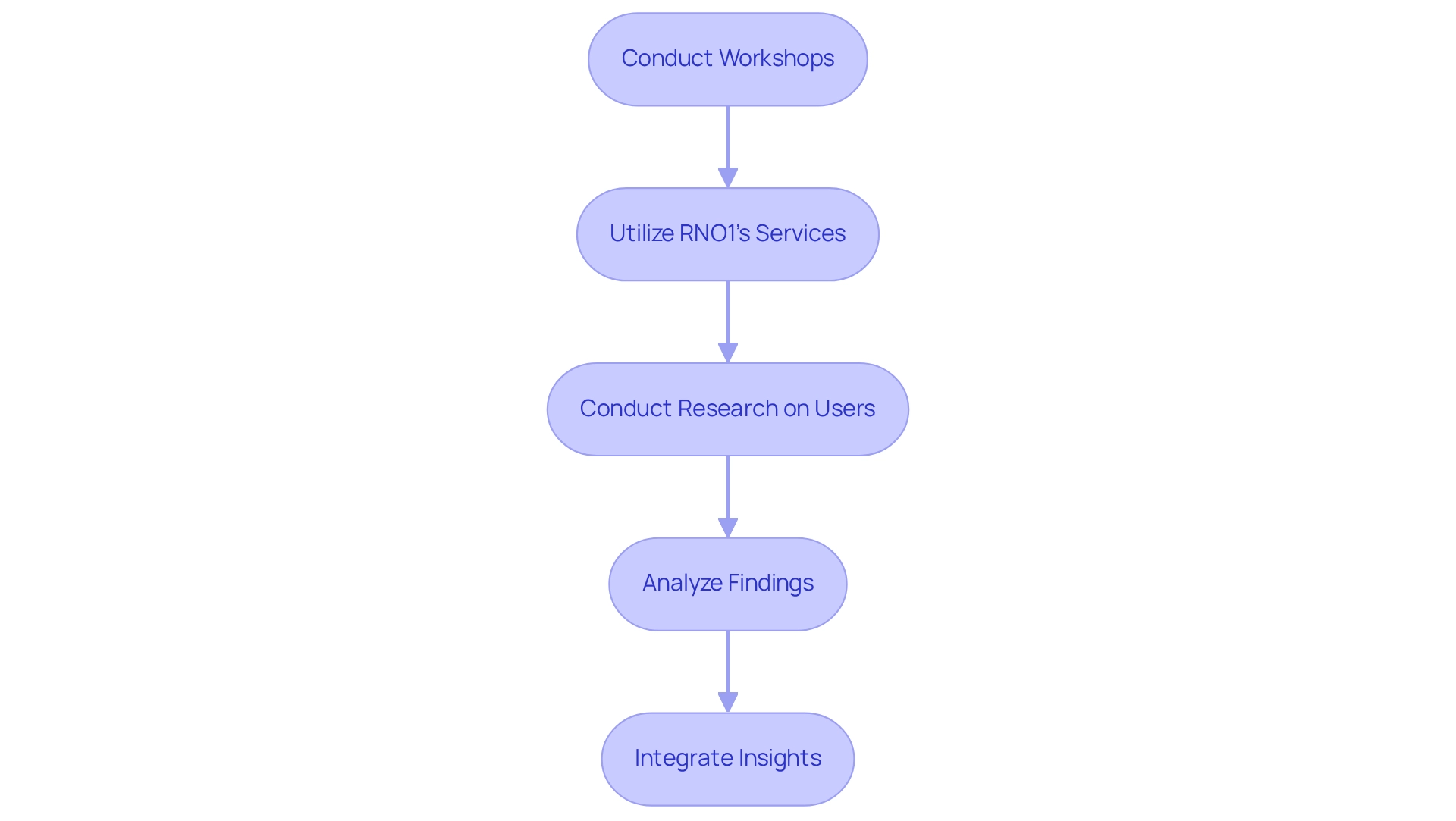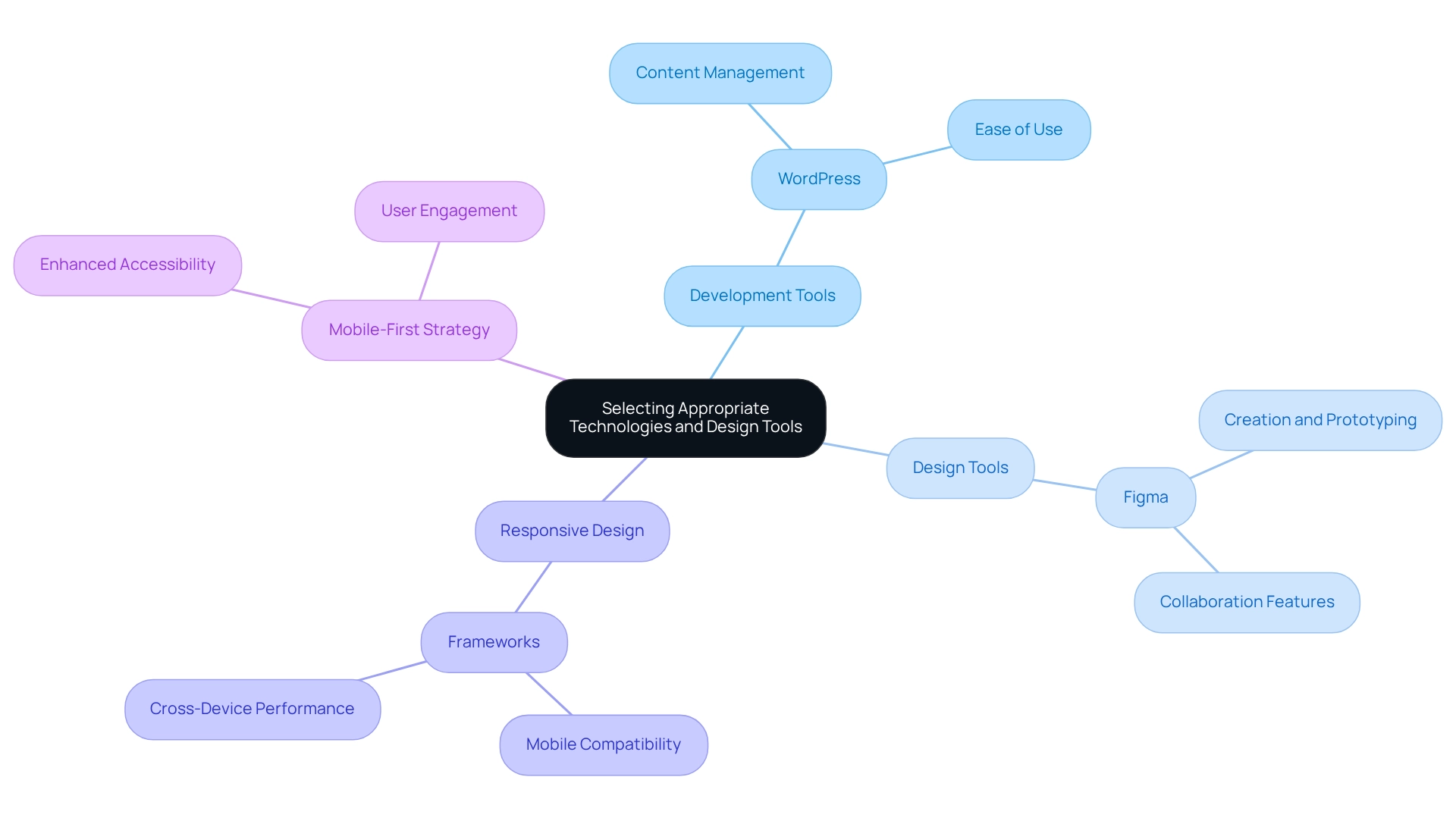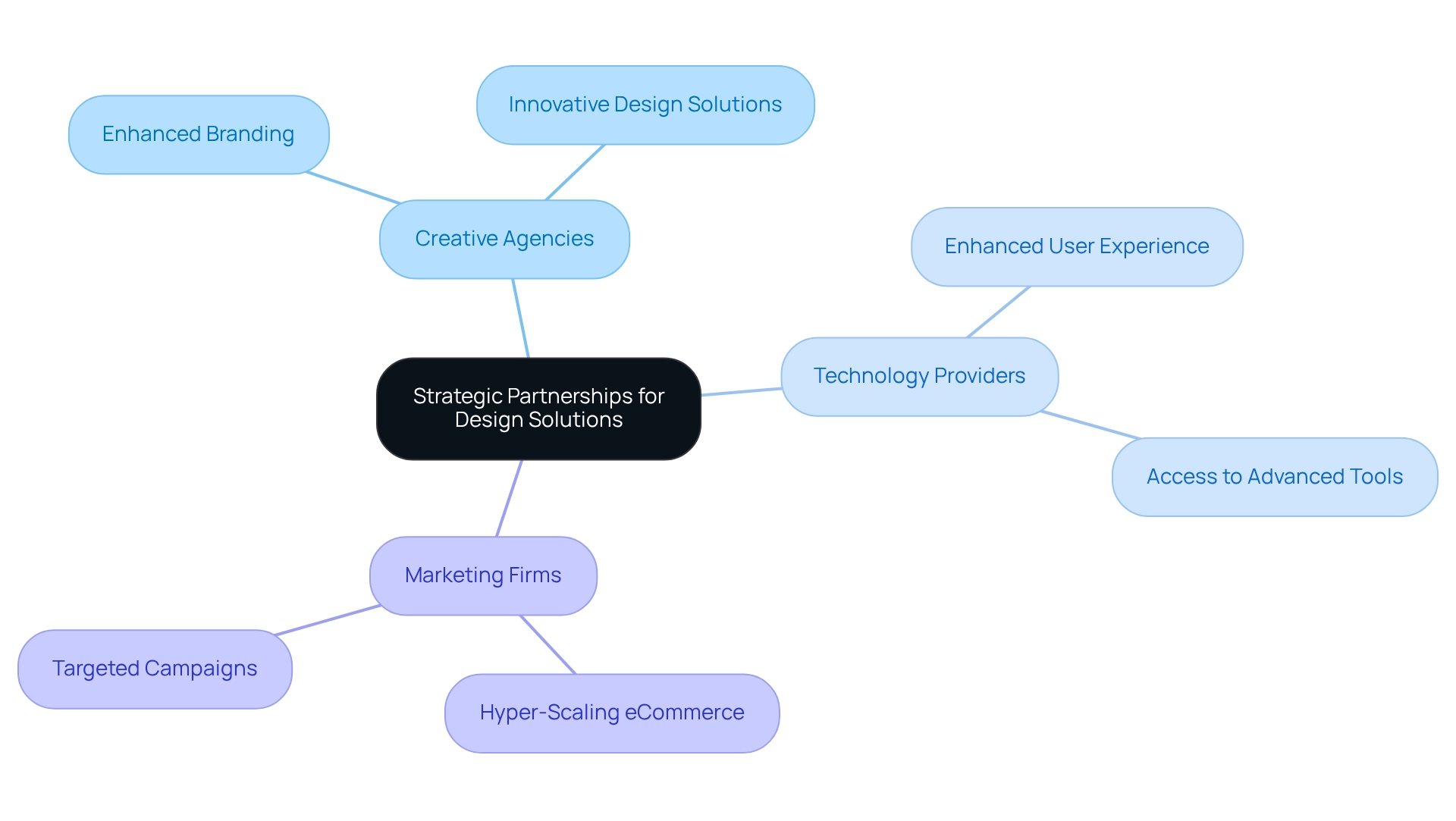Overview
In today's digital landscape, many companies struggle with crafting an effective online presence. This challenge can lead to missed opportunities and a disconnect with users, leaving them feeling unheard and unvalued. To address this, it’s essential for companies to embrace four fundamental practices that can transform their web design efforts.
Firstly, defining brand identity and understanding user needs are crucial steps. By taking the time to truly listen to users and understand their preferences, companies can create a website that resonates on a personal level. This not only enhances user satisfaction but also fosters loyalty and trust.
Next, selecting the appropriate technologies is vital. The right tools can make a significant difference in how a website performs and how users interact with it. Companies should consider their specific needs and choose technologies that align with their goals, ensuring a smooth and engaging experience for users.
Implementing continuous improvement is another essential practice. The digital world is ever-evolving, and companies must be willing to adapt and refine their strategies based on user feedback and emerging trends. This commitment to growth not only enhances the user experience but also demonstrates a company’s dedication to its audience.
Lastly, fostering strategic partnerships can amplify a company’s efforts. Collaborating with others in the industry can bring fresh perspectives and innovative ideas, enriching the overall web design process. By leveraging these partnerships, companies can enhance their online presence and create a more fulfilling experience for users.
By adopting these practices, companies can transform their web design from a daunting task into an opportunity for connection and growth. Understanding user preferences and leveraging the right tools and collaborations can lead to a more meaningful online presence, ultimately enhancing the overall user experience. Together, let’s embark on this journey towards a more empathetic and engaging digital world.
Introduction
In today's competitive digital landscape, many businesses find themselves struggling to craft a compelling online presence. This challenge can feel overwhelming as companies navigate the complex process of defining their brand identity, understanding user needs, and selecting the right technologies to create a website that truly resonates with their audience. The implications of these struggles are significant; without a clear strategy, businesses may miss opportunities to connect with potential customers.
However, there is hope. By embracing strategic planning and user research, organizations can embark on a journey of continuous improvement, adapting to the ever-evolving market demands. Fostering strategic partnerships and leveraging the right design tools can enhance web solutions, ensuring that businesses not only attract users but also provide an engaging and functional experience.
Together, let’s explore the essential steps and strategies that can empower your business to thrive in the digital realm.
Define Your Brand Identity and User Needs
To begin with, many companies struggle to articulate their brand identity, which encompasses their mission, vision, and core values. This challenge can feel overwhelming, especially for tech startup founders who are passionate about their work. However, there is hope. Engaging in workshops or brainstorming sessions with key stakeholders can be a nurturing way to clarify these essential elements. RNO1 offers 'Brand Strategy & Experience Guidelines' to assist in defining this identity effectively, providing a supportive framework for growth.
Once the brand identity is established, it is crucial to recognize the importance of performing audience research. Understanding the needs and preferences of the target demographic can be transformative. Techniques such as surveys, interviews, and usability testing can provide valuable insights. For instance, a tech startup might discover that its clients prioritize speed and efficiency. By acknowledging these priorities, companies web design can make informed choices that enhance performance and usability. By incorporating these insights into the companies web design process, organizations can create a website that not only looks appealing but also meets the practical requirements of its audience.
Steps to Define Brand Identity and User Needs:
- Conduct Workshops: Gather key stakeholders to brainstorm and articulate the brand's mission, vision, and values in a collaborative environment.
- Utilize RNO1's Services: Implement 'Brand Strategy & Experience Guidelines' to refine the brand identity with expert guidance.
- Conduct Research on Users: Use surveys and interviews to collect insights on user preferences, ensuring their voices are heard.
- Analyze Findings: Identify key priorities of individuals, such as speed and efficiency, to understand what truly matters to them.
- Integrate Insights: Use these discoveries to improve site layout, ensuring it fulfills visitor requirements and resonates with their needs.
By adhering to these measures, organizations can strengthen their brand through customer-focused strategies and foster market acceptance. A recent project with a tech startup revealed that by prioritizing user feedback, they significantly improved their website's performance, leading to increased user satisfaction and engagement. This journey illustrates the power of and adapting to their needs, creating a sense of community and support that is invaluable for growth.

Select Appropriate Technologies and Design Tools
When tech startup founders face the challenge of choosing the right technologies and , it can feel overwhelming. The pressure to ensure scalability, ease of use, and integration capabilities weighs heavily on their shoulders. Popular tools like Figma for creation and WordPress for content management can truly make a difference, streamlining the development process and alleviating some of that stress. Additionally, embracing responsive design frameworks is crucial, as they ensure that a website performs beautifully across various devices.
Consider a startup that decides to adopt a mobile-first strategy, prioritizing the mobile experience. This thoughtful approach not only enhances accessibility but also fosters greater engagement with users. By selecting the right tools, companies web design can create a strong online presence that not only elevates their branding initiatives but also meets the expectations of their audience. Remember, you are not alone in this journey; by leveraging the appropriate resources, you can navigate these challenges with confidence and compassion.

Implement Continuous Improvement and User Feedback Mechanisms
In today's fast-paced digital landscape, organizations often struggle with the challenge of ongoing enhancement. It can be disheartening to realize that without effective feedback systems, such as surveys, response forms, and usability testing sessions, valuable insights may slip through the cracks. This oversight can lead to missed opportunities for growth and connection with your audience.
For instance, if you notice a high bounce rate on a particular page, it might feel frustrating and overwhelming, but this is a chance to redesign and enrich content engagement. Tools like Hotjar or Google Analytics can be your allies in this journey, helping you and pinpoint areas ripe for improvement.
By actively seeking and embracing feedback from clients, you create a nurturing environment where your online platform can evolve in harmony with client expectations and industry trends. Remember, every piece of feedback is a stepping stone toward a more engaged and satisfied audience, and together, we can foster a culture of continuous growth and understanding.

Foster Strategic Partnerships for Enhanced Design Solutions
In today’s fast-paced digital landscape, many tech startups face the challenge of standing out and achieving success. This struggle can often feel overwhelming, especially when trying to navigate the complexities of branding and user experience on their own. However, there is hope. Companies can significantly benefit from actively pursuing collaborations with creative agencies, technology providers, and marketing firms that resonate with their objectives.
For example, RNO1's strategic rebranding of Founder's Haven beautifully illustrates how collaboration can empower modern founders to reach their digital aspirations. By partnering with a UX development agency, a tech startup can enhance its platform's user experience, leading to innovative solutions that may otherwise remain out of reach.
Furthermore, RNO1's performance marketing expertise, highlighted in their case study with Cirkul, demonstrates the remarkable potential for hyper-scaling eCommerce through effective partnerships. Engaging in industry networks and attending conferences can also open doors to potential collaborators.
By nurturing these strategic partnerships, companies' web design can enhance their design capabilities and ensure their website truly stands out in a competitive digital environment. Together, we can create a where every startup has the opportunity to shine.

Conclusion
Establishing a compelling online presence can feel overwhelming for businesses navigating the complexities of the digital landscape. It often begins with the challenge of defining a clear brand identity and truly understanding user needs. Through strategic workshops and thoughtful user research, companies can articulate their mission, vision, and values, creating a foundation that resonates with their target audience. This connection ultimately leads to a more engaging and functional website that reflects their dedication to serving users.
Choosing the right technologies and design tools is equally crucial in this journey. Companies must prioritize scalability, ease of use, and responsive design to ensure their websites perform seamlessly across various devices. By leveraging modern tools like Figma and WordPress, businesses can streamline their development process, enhancing user experience and creating a robust online presence that meets customer expectations with compassion.
Continuous improvement and user feedback mechanisms are vital components for success. Regularly seeking user input through surveys and usability testing allows companies to adapt their websites based on real-time data. This adaptability ensures they remain aligned with user preferences and industry trends. Furthermore, fostering strategic partnerships with design agencies and technology providers can elevate a company’s design capabilities, leading to innovative solutions that enhance overall user experience and reflect a commitment to growth.
In conclusion, by embracing strategic planning, user-centered design, and collaborative partnerships, businesses can truly thrive in the digital realm. These essential steps empower companies to connect with potential customers while fostering a culture of continuous improvement that is vital for long-term success in a competitive market. The time to take action and enhance your online presence is now, and you are not alone on this journey.
Frequently Asked Questions
What is brand identity, and why do companies struggle to articulate it?
Brand identity encompasses a company's mission, vision, and core values. Many companies, particularly tech startups, struggle to articulate their brand identity because it can feel overwhelming for passionate founders.
How can companies clarify their brand identity?
Companies can clarify their brand identity by engaging in workshops or brainstorming sessions with key stakeholders, which provides a collaborative environment to define essential elements.
What services does RNO1 offer to help define brand identity?
RNO1 offers 'Brand Strategy & Experience Guidelines' to assist companies in effectively defining their brand identity and providing a supportive framework for growth.
Why is audience research important after establishing brand identity?
Audience research is crucial because it helps companies understand the needs and preferences of their target demographic, which can transform their approach and improve their offerings.
What techniques can be used for audience research?
Techniques for audience research include surveys, interviews, and usability testing, which provide valuable insights into user preferences.
How can understanding user priorities impact web design?
By understanding user priorities, such as speed and efficiency, companies can make informed decisions that enhance the performance and usability of their website.
What are the steps to define brand identity and user needs?
The steps include conducting workshops, utilizing RNO1's services, conducting user research, analyzing findings, and integrating insights into the web design process.
What benefits can organizations gain by following these steps?
By following these steps, organizations can strengthen their brand through customer-focused strategies, foster market acceptance, and improve user satisfaction and engagement.
Can you provide an example of the impact of prioritizing user feedback?
A recent project with a tech startup demonstrated that prioritizing user feedback significantly improved their website's performance, leading to increased user satisfaction and engagement.




